The cinema market of Kolkata/West Bengal has primarily been dominated by Bengali cinema since the last 5 years. The market leader is Venkatesh Films, a company with huge production & distribution networks. The company produces both critically acclaimed art as well as blockbuster commercial films. Additionally, it produces fiction and non-fiction reality shows for Bengali GEC channels such as Star Jalsha, Rupashi Bangla and Mahuaa Bangla; has a very strong distribution chain with total control of over 200 theatres of WB (films such as Raavan and 3 Idiots were released on WB. through their network); and has created superstars in the cinema of Bengali who involve themselves in promoting the company’s films all through the year.
Almost all the stars in Kolkata, from directors such as Raj Chakraborty, Srijit Mukherjee, Ravi Kinagi, Sujit Mondal, and Rajeev Kumar; actors such as Dev, Jeet, Soham, Koel, Subhosree, Shravanty, and Payel; music directors such as Jeet Ganguly, Anupam Roy, and Debojyoti Mishra; editors such as Rabiranjan Moitra; to art directors such as Tanmoy Chakraborty, and Asish Adhikari are discoveries of Venkatesh Films. A majority of them are, naturally, loyal to their company and as a rule do not work for other producers.
Among the young generation of Bengali cinema audience, Dev has an extremely large fanbase and well before the release of each of his films, his fans tend to go into a frenzy and there is frequently a scarcity of tickets. Furthermore, Venkatesh Films creates a huge publicity buzz before each of its film’s releases, so much so that time even good Hindi or English films releasing in the same week are literally compelled to pray for footfalls.
MARKET SIZE OF BENGALI FILM INDUSTRY
- Box office – 101 Crores ( Producer share – 45 Crs )
- Other rights – 21 Crs ( based on current situation )
- 85 – 100 releases in a year
- COP – 40 lacs to 250 lacs
- Digital – 20 lacs to 60 lacs
- 515 cinema halls ( 11 multiplexes ) is the universe
- Urban appealing movies are of high budget
- Marketing & distribution spend – 15% to 40%
- Mainstream cinema contributes 80% of business
- Art house cinema has only strength in metro
EXISTING CONTENT
- Two categories
- Metro centric/Art/Intellectual ( ~ 35 no. ) & mainstream/Commercial ( ~ 65 no. )
- Big opportunity to bridge the gap
- Success story is star/content driven for Mainstream & Story approachingsocial message is utmost important for Arthouse
- Genres working well in Mainstream – Young love story, Actions & Comedy
- Art House Directors came up Aniruddha, Bappaditya, Bratyo, Suman(2) since last two years
- Mainstream dominated by Raj Chakravarty, Rajib kumar,Ringo apart from Swapan Saha, Haranath, Ravi Kinnagi etc.
- The stallwards of Art house cinema are still Rituparno, Aparna, Buddhadev, Shekhar Das & Anjan Dutta.
BOX OFFICE RECENT PAST
- 52 Films releases in 2007. 1 declared Super Hit followed by 12 hit. ( hitmeans recovered money )
- 65 released in 2008. Two again Super Hit followed by 10 hit.
- Already 87 released in 2009 & 3 Super Hit again.
- MLA FATAKESTO, TULKALAM – Over 4 years Super Hit
- CHIRO DINI TUMI JE AMAR Broken all the records in 2008 ( no star –surprise hit ) followed by CHALLENGE same team.
- CHALLENGE & PJJR (2009) has created again history in quick recovery
- FELUDA KIND OF MOVIES are always a safe as a franchisee
MARKETING
- Newspaper, TV, Radio, Website, Publicity & Ground Activities
- Word of Mouth & Star Power
- Music Video is the key tool
- Urban Movies has much focus in Metro
- Well planned with Editorial support from media
- Common media buying
- Exclusive media tie up
- In film branding just started
DISTRIBUTION
- Dominated by VENKATESH followed by Eskay Films & Surinder Films Strong control on Exhibitors
- Bookers also has very strong network but traditional
- Urban films confined to Metro & Suburbs only
- Mainstream film can give the width
- Monopoly & long relationship with the exhibitors
- Emerging distributor PIYALI FILMS with strong system support
EXHIBITION
- Universe is 515 – 37 A+ halls & 53 A halls
- 106 halls have UFO facilities. CUBE digital launched in bengal & 135 cube installed already.
- Some 209 halls closed completely
- Average ticket price is 40/- to 70/- in urban to 10/- to 25/- in suburbs
- Can achieve 1 Cr. easily if its full show for a week with 60% occupancy.
- Venkatesh trying to get 107 sick halls, got already 47 halls leased by him.
- Piyali Films are growing heavily in strategising their entertainment wing to a diversified revenue source apart from their traditional business.
WAY FORWARD PRODUCTION & CONTENT
- Priority on new stories, new stars & new directors
- At least 6 movies is getting signed by each & every producers
- Genre is contemporary based on Love, Masala
- Buying stories which is rich & best sellers
- Signing good & new directors on contracts
- Banking on new actors & actress
- Doing R&D for public domain
- Remake of Tamil, Telegu, Oriya & Hindi Blockbusters i.e. only in Mainstream
WAY FORWARD DISTRIBUTION
- High dependency on digitals
- Penetration initial 2 weeks with max no of theatres
- Some guys like Piyali Films adopted system very strongly Producer- Distributor planned year’s release well in advanceBig brothers started creating own chain
- Multiplex creating troubles for show timing
- Still no space for Mainstream in Multiplexes
WAY FORWARD MARKETING
- Taken a big leap beyond KOLKATA
- NEW STARS exploited more in all activities.
- IN FILM is on high focus which adding 20% revenues
- Media Buying are essentially combined with tie up
- Radio & Website has opened a phenomenal information inflow Hyped programme opens for release platform
- Corporates investing money for Outdoor Media
- FOOD JOINT is being targeted as a key zone for Youth.
BRANDING & TIE UP
- FESTIVALS are being targeted for a big budget movie
- Corporate Co- branding is happening
- Alliances are giving enormous mileage
- Local Companies are highly pitching on movies
- Barter deal is saving a substantial planned cost
- College & Campus creating platforms for certain kind of films REGIONAL ICONS are placed in promoting the films in Premiere.
Objective of the Project
- An audience research study is conducted to identify the habit & preference of the cinema-going audiences.
- The objective of this project also involves reason behind less watch or not watch of English movie.
Research Methodology
This research methodology was developed after considering the research objectives and the purpose of the project seriously.
The Market Research Process
The market research process consists of six steps. These include:
- Problem definition
- Development of an approach
- Research Design Formulation
- Field Work
- Data Interpretation and Analysis
- Report Preparation.
Research Design
Keeping the research objectives in mind, a research design was developed for conducting the study and collecting the required data.
- Research Instrument: A questionnaire was formulated. Most of the questions were closed-ended & a very few were open-ended.
- Nature of Data: All the data used for this project were primary in nature.
- Source of Data: The data collection method was that of Survey research,which in terms of marketing is defined as a ‘Systemic Collection of Information directly from the respondents.’
- Sampling Plan: The sample unit or target group is the cinema-going audience of Kolkata. They are of age group between 18 to 35 yr. and fall into various segments on the basis of gender, education, profession & locality.
- Sample Size: Total number of consumers surveyed was 138.
- Area Covered: At first single screen theaters & multiplexes were divided into various parts according to their geographic position & profile of audiences.
- Theatres covered for this survey:
- INOX (SWABHUMI / CITY CENTRE / FORUM)
- FAME (SOUTH CITY / HIGHLAND PARK)
- CINEMAX (MANI SQUARE)
LONDON PARIS (MUKTI WORLD) - HDIL BROADWAY BIOSCOPE
NEW EMPIRE STAR - PARADISE ROXY
- AJANTA PRACHI PRIYA NAVINA JAYA NANDAN INDIRA
- Contact Method: Data was collected by field survey via direct interview by the investigator to the respondents.
Constraints of the Project
- Time Constraint: One of the main shortfalls of the research study was that the survey period was limited. Hence, because of this time constraint, more number of respondents could not be covered.
- Variation of movie: Actually to understand the taste & preference of audience is a long time process, audience profile varies from season to season, ie. During festivals a wide variety of audience go theatre to enjoy movie, who may be laggards. Their taste & preference is also important to bring them at theatre.
Although care has been taken in putting across the observations meticulously, yet these constraints of information tend to cause some minor aberrations in the final analysis.
Design of the Questionnaire
A questionnaire contains a formalized set of questions for obtaining information from respondents. Typically a questionnaire is one element in data collection package that might also include
- · Field work procedures such as instruction for selecting, approaching and questioning respondents.
- · Some reward, gift or payment offered to respondents. Any questionnaire has three specific objectives:First, it must translate the information needed into set of specific questions that the respondents can and will answer. Developing questions that respondents cannot answer may render the collection of information difficult.
Second, a questionnaire must uplift, motivate and encourage the respondents to co-operate and to complete the interview. Incomplete questionnaires have limited usefulness. The questionnaire must be so designed that it minimizesthe respondent’s fatigue and boredom. A well-designed questionnaire can motivate the respondents and increase the response rate.
Third, a questionnaire should minimize the response error.
Hence, the questionnaire for this project is designed keeping these information in mind.
Interviewing Method
An appreciation of how the type of interviewing method influences questionnaire design can be obtained by considering how the questionnaire will be administered under each method. In personal interview, the respondents see the questionnaire and interact fact-to-face with the interviewer. Thus various questions can be asked. In case of indirect interviewing method like through Email or mail, the questionnaire should be brief and easily understandable. Hence, for this project we have used mostly all primary data.
In case of my project, the survey has been conducted by myself where I have personally visited theatres of Kolkata and interviewed the respondents. In this regard, I have tried my level best to keep the questionnaire respondent-friendly.
[divider text=”” size=”1″ margin=”0″]
Questionnaire: AUDIENCE RESPONSE SHEET
Objective: To understand the habits & preferences of Bengali cinema-going audiences
Part
- Name:
- Gender
- Age:
- Locality
- Profession
- Education
- Contact no. &/or E-mail id
Sub-Objective 1: How genre of film varies from segment to segment
Sub-Objective 2: Who are the target audience of ART of COMMERCIAL movie?
Sub-Objective 3: Which is/are the preferred language(s) in which audience enjoys a movie?
Sub-Objective 4: What combination of ingredients, the audience would like to watch a movie?
Sub-Objective 5: What is the preferred Showtime
Sub-Objective 6: What is the preferred mode to purchase movie tickets?
Sub-Objective 7: When audience prefers to visit theatre after release of a movie
Sub-Objective 8: What are the sources of information about a movie?
AUDIENCE RESPONSE SHEET
- · Where do you watch films – Theatres, TV, CD/DVD
- · Why do you watch the films in this format (put some thought into this)?
- · Do you watch TV?
- What channels do you watch?
- Which programs?
- Which language?


Technique and Theory for Data Analysis
Some mathematical and statistical tools were used for the analysis of different objectives of the project. The Statistical techniques used are as follows.
Percentage Distribution: Where the number in each category is expressed as a percentage of the total.
Bar Diagram: Pictorial representation of equidistant rectangular bars, one for each category is used to represent the data.
Pie Chart: A pictorial representation where circle is used to represent the total area and is divided proportionally among the different components by converting the proportional values into proportional segments of the circle.
Thurston technique of ranking: An analysis which helps in ranking different attributes according to their importance and also the distance between their levels of importance.
[box title=”Thurston Scale” style=”default” box_color=”#333333″ title_color=”#FFFFFF” radius=”3″]In psychology, the Thurston scale was the first formal technique for measuring an attitude. It was developed by Louis Leon Thurston in 1928 as a means of measuring attitudes towards religion. It is made up of statements about a particular issue, and each statement has a numerical value indicating how favorable or unfavorable it is judged to be. People check each of the statements to which they agree, and a mean score is computed, indicating their attitude. Thurston’s Method of Paired Comparisons can be considered a prototype of anormal distribution-based method for scaling-dominance matrices.[/box]
Research Analysis
Ranking by audience about their preference regarding genre of movie
Genre of films is divided into: Romantic, Drama, Action, Thriller, Comedy, and Experimental. In below audiences are segmented into various parts & how preferences of genre of film varies from segment to segment, that was measured.
RANKING BY AUDIENCE ABOUT THEIR PREFERENCE REGARDING GENRE OF MOVIE
In the below
- R’ stands for ROMANTIC
- ‘D’ stands for DRAMA
- ‘A’ stands for ACTION
- ‘T’ stands for THRILLER
- ‘C’ stands for COMEDY
- ‘E’ stands for EXPERIMENTAL
Overall Ranking


INFERENCE: From above analysis it can be said that overall preference of cinema-going audience of Kolkata regarding genre of movie is Romantic movie & closely followed by Comedy movie. Drama is least preferred by them.
GENDER-WISE RANKING
[A]FEMALE RANKING


INFERENCE: From above analysis it can be said that overall preference of female cinema-going audience of Kolkata regarding genre of movie is Romantic movie & followed by Comedy movie. Drama is least preferred by them.
[B] MALE RANKING:


INFERENCE: From above analysis it can be said that preference of male cinema-going audience of Kolkata regarding genre of movie is Action movie, followed by Comedy movie. The market position of Romantic & Thriller movie is same. Drama is least preferred by them.
AGE-WISE RANKING
[A] LESS THAN 22 yr.

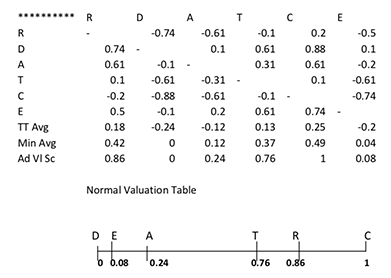
INFERENCE: From above analysis it can be said that preference of cinema- going audience of age group less than 22yr. regarding genre of movie is Comedy movie & closely followed by Romantic movie. Drama is least preferred by them.
[B] UPTO LESS THAN 23 yr.


INFERENCE: From above analysis it can be said that l preference of cinema- going audience of age group less than 23yr., regarding genre of movie is Romantic movie & closely followed by Comedy movie. Drama is least preferred by them.
[C] 22yr. to less than 28 yr.


INFERENCE: From above analysis it can be said that preference of cinema- going audience of Kolkata regarding genre of movie is Romantic movie & closely followed by Comedy movie. Drama is least preferred by them.
[D] 28 yr. To 35 yr.


INFERENCE: From above analysis it can be said that preference of cinema- going audience of age group between 28 to 35yr., regarding genre of movie is comedy movie, followed by romantic & experimental movie. Overall market position of romantic & experimental movie is same. Drama is least preferred by them.
LOCALITY-WISE RANKING
[A] SOUTH KOLKATA
(Includes Jadavpur, Jodhpur park, Golf-club, Selimpur, Garia, Mahamayatala, Patuli, Bansdroni, Kasba, Ruby Santoshpur, Picnic garden, Tollygung, Golpark, Rashbehari, Hazra, Bhowanipur, New-Alipur, Behala, Parnashree, Baruipur.)

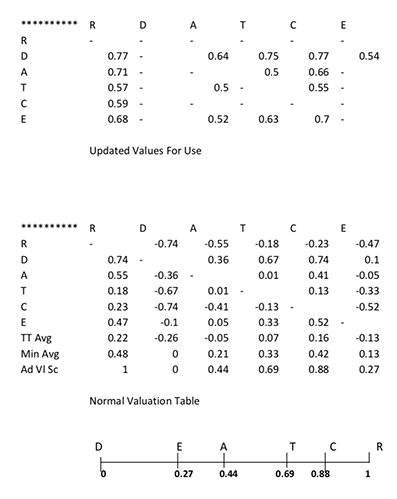
INFERENCE: From above analysis it can be said that preference of cinema- going audience of south kolkata regarding genre of movie is Romantic movie & followed by Comedy movie. Drama is least preferred by them.
[B] NORTH KOLKATA & ITS SURROUNDING
(Includes Shyambazar, Hatibagan, Baguiati, Saltlake, New town, CIT road, Beliaghata, Dumdum)


INFERENCE: From above analysis it can be said that preference of cinema- going audience of North Kolkata regarding genre of movie is Comedy movie & closely followed by Romantic movie. Drama is least preferred by them.
[C] PART of NORTH 24PGS,HOWRAH, HOOGLY ATTACHED TO KOLKATA
(Includes Howrah, Shibpur, Kalyani,Chinsurah, Chandannagar, Barasat, Naihati,Serampur, Baranagar, Belghoria, New Barackpur)


INFERENCE: From above analysis it can be said that preference of cinema- going audience of attached part of Kolkata, regarding genre of movie is Comedy movie & very closely followed by Romantic movie. Drama is least preferred by them.
PROFESSION-WISE RANKING
[A] Working professionals:


INFERENCE: From above analysis it can be said that preference of cinema- going audience of service professionals, regarding genre of movie is Romantic movie & followed by Comedy movie. Drama is least preferred by them.
[B] STUDENT


INFERENCE: From above analysis it can be said that preference of cinema- going students, regarding genre of movie is Comedy movie, closely followed by Romantic &Thriller movie. Drama is least preferred by them.
EDUCATION-WISE RANKING
[A] GRADUATE OR UNDERGRADUATE


INFERENCE: From above analysis it can be said that preference of cinema- going graduate or undergraduate audience regarding genre of movie is Romantic movie , closely followed by Comedy movie. Drama is least preferred by them.
[B] POST-GRADUATE OR STUDENT OF POST-GRADUATE
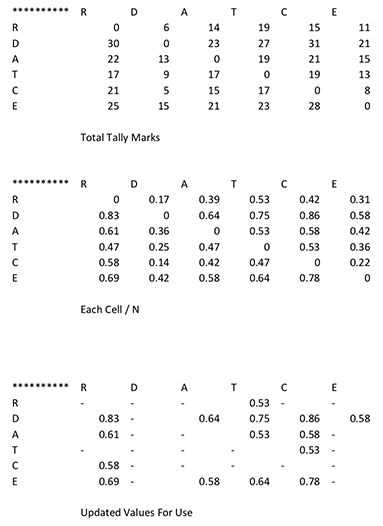

INFERENCE: From above analysis it can be said that preference of cinema- going post-graduate audience regarding genre of movie is Romantic movie &Comedy movie. Both have same ranking. Drama is least preferred by them.
ONLY ART FILM AUDIENCE


INFERENCE: From above analysis it can be said that preference of art film audience regarding genre of movie is Comedy movie. Drama is least preferred by them.
ONLY COMMERCIAL FILM AUDIENCE

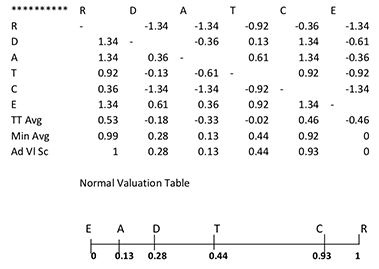
INFERENCE: From above analysis it can be said that preference of only commercial movie audience regarding genre of movie is Romantic movie, closely followed by Comedy movie. Experimental movie is least preferred by them.
GENERALLY ART FILMS, SOMETIMES COMMERCIAL FILM AUDIENCE


INFERENCE: From above analysis it can be said that preference of this segment of movie audience regarding genre of movie is Romantic movie, closely followed by Action, Comedy & Thriller movie. Drama is least preferred by them.
GENERALLY COMMERCIAL FILM AUDIENCE


INFERENCE: From above analysis it can be said that preference of this segment of movie audience regarding genre of movie is Romantic movie, followed by Comedy & Thriller movie.
ENGLISH & HINDI MOVIE AUDIENCE


INFERENCE: From above analysis it can be said that preference of this segment of movie audience regarding genre of movie is Comedy movie, closely followed by Thriller movie.
HINDI & BENGALI MOVIE AUDIENCE

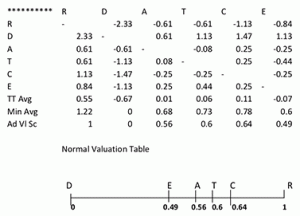
INFERENCE: From above analysis it can be said that preference of this segment of movie audience regarding genre of movie is Romantic movie, followed by Comedy & Thriller movie.
ENGLISH, HINDI & BENGALI MOVIE AUDIENCE


INFERENCE: From above analysis it can be said that preference of this segment of movie audience regarding genre of movie is Romantic & comedy movie, overall preference of this segment of audience regarding Romantic & comedy movie is same. Drama is least preferred by them.
MARKET OF ART & COMMERCIAL MOVIE
Movies are broadly divided into 2 types: art film & commercial film. For this survey, audiences were asked which kind of film(s) is/are watched by them to know their preferences. The options were as following:
-
- [A] Audience of Only ART / INTELLECTUAL films which is expressed as A in chart below.
- [B] Audience of Only COMMERCIAL films which is expressed as B in chart below.
- [C] Audience of Generally ART / INTELLECTUAL films & sometimes COMMERCIAL films which is expressed as C in chart below.
- [D] Audience of Generally COMMERCIAL films & sometimes ART / INTELLECTUAL films which is expressed as D in chart below.
People watch or like to watch art or commercial movie according to their taste & preferences.
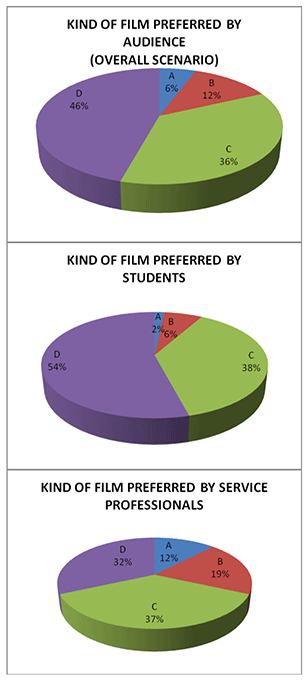
PREFERENCE OF AUDIENCE TOWARDS LANGUAGE OR COMBINATIONS OF LANGUAGES
In Kolkata, mainly 3 languages of films run at theatres: English, Hindi, and Bengali. Apart from that Tamil & Bhojpuri films also have a very small market. During survey, audiences were asked about various combinations of languages of film, which they generally watch or prefer to watch.
The total scenario is represented below, in chart form.

MOST PREFERRED COMBINATION OF A MOVIE
To understand the preference of the audience, they were asked that if a cinema will be made according to their choice, then what would be their preferred combination. The ingredients were romance, action, comedy & drama and audience had to response their choice as % against each ingredient.
The main ingredients of a film: Romance, Action, Comedy & Drama may be at any of the following 3 states, i.e. high (0 to < 20%), medium (20 to <60%), low (60 to 100%).High state is decoded as 1, medium state is decoded as 2 & low state is decoded as 3.
Outcome from service professionals:
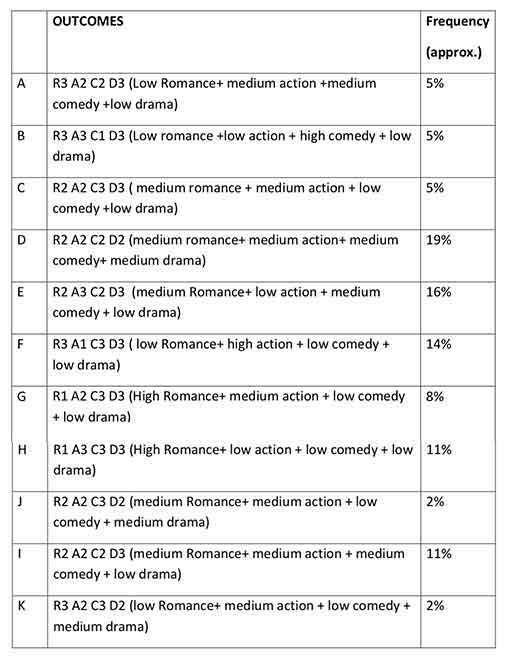
Outcome from students:

Market viable outcomes:

Total sample size for this question: 100 (Student: 63 & Service: 37):


Preferences about show time:
Preferences about mode of purchase of movie ticket
How movie ticket are purchased
- Online
- Advance
- Current
- By friends or family members
- The group of audiences who purchase ticket through friends or family members; they are not decision maker regarding purchase of movie tickets.

ROGERS ADOPTION-INNOVATION MODEL
Adopter categories
Rogers defines an adopter category as a classification of individuals within a social system on the basis of innovativeness. In the book Diffusion of Innovations, Rogers suggests a total of five categories of adopters in order to standardize the usage of adopter categories in diffusion research. The adoption of an innovation follows an S curve when plotted over a length of time. The categories of adopters are: innovators, early adopters, early majority, late majority, and laggards.
Adopter category Definition
- [A]Innovators: Innovators are the first individuals to adopt an innovation. Innovators are willing to take risks, youngest in age, have the highest social class, have great financial lucidity, very social and have closest contact to scientific sources and interaction with other innovators. Risk tolerance has them adopting technologies which may ultimately fail. Financial resources help absorb these failures.
- [B] Early Adopters: This is the second fastest category of individuals who adopt an innovation. These individuals have the highest degree of opinion leadership among the other adopter categories. Early adopters are typically younger in age, have a higher social status, have more financial lucidity, advanced education, and are more socially forward than late adopters. More discrete in adoption choices than innovators. Realize judicious choice of adoption will help them maintain central communication position.
- [C] Early Majority: Individuals in this category adopt an innovation after a varying degree of time. This time of adoption is significantly longer than the innovators and early adopters. Early Majority tend to be slower in the adoption process, have above average social status, contact with early adopters, and seldom hold positions of opinion leadership in a system.
- [D] Late Majority : Individuals in this category will adopt an innovation after the average member of the society. These individuals approach an innovation with a high degree of skepticism and after the majority of society has adopted the innovation. Late Majority are typically skeptical about an innovation, have below average social status, very little financial lucidity, in contact with others in late majority and early majority, very little opinion leadership.
- [E] Laggards: Individuals in this category are the last to adopt an innovation. Unlike some of the previous categories, individuals in this category show little to no opinion leadership. These individuals typically have an aversion to change-agents and tend to be advanced in age. Laggards typically tend to befocused on “traditions”, likely to have lowest social status, lowest financial fluidity, be oldest of all other adopters, in contact with only family and close friends, very little to no opinion leadership.

Rogers model is utilized to segment the audiences as innovator, Early adopter, early majority, late majority, laggards. Among Cinema going audience there are some people, who always try to watch movie at the early days of release. There are also some people, who watch movie after a long time of release . Cinema going audience can be classified as per Rogers model.
In a 4 week life span of cinema the audience can be divided as follow:
- INNOVATORS
- EARLY ADOPTERS
- EARLY MAJORITY
- LATE MAJORITY
- LAGGARDS
The audience were asked, when they go to watch a film after release? The options were as follows:
- Always try to watch movie 1st day 1st show
- Try to watch movie within 1st 3days of release
- Try to watch movie within 1st week of release
- Watch movie at 2nd to 3rd week, after recommendation by friends
- Watch movie after long time of release, when reviews & feedback become good


SOURCES OF INFORMATION REGARDING A MOVIE
Audiences were asked about the sources of information regarding a movie. This was an open-ended question & feedback was plotted in pie-chart form below.
PRINT MEDIA

 TV CHANNELS
TV CHANNELS


FM CHANNELS

MISC. SOURCES

WHAT IS THE REASON TO WATCH MOVIE AT A THEATRE OR ON TV OR CD/DVD?
During the survey this question was asked to the audience. This was an open- ended question & feedbacks is as noted below.
REASON TO WATCH MOVIE AT THEATRE
- Good picture & sound quality at theatre.
- Likes to enjoy movie with friends or loved ones which cant possible athome.
- It’s possible to forget all the external pressure during that time.
- It’s easy to be familiar with characters at big screen.
- It’s a part of outing or get together.
- Likes to watch film when it release.
- Fewer disturbances.
REASON TO WATCH MOVIE ON TV
- No investment of money.
- No need to travel anywhere.
- Movies can be enjoyed at favourable time.
REASON TO WATCH MOVIE ON CD/DVD
- Less investment of money.
- Can see a movie at favourable time.
- Can pause or stop at any time.
- Not too much shout like local theatres.
- Repeat watch is possible.
- A person can enjoy 5 movies only for Rs.25, then why will he invest Rs. 100 for a movie.
- All family members can enjoy a pirated movie DVD at cost of less than Rs. 1 to watch a movie (assumed that, no. Of family members: 5 & DVD contains 5 movies at Rs. 25), so why price-sensitive people will invest Rs. 100 per head for a movie?
REASON FOR LESS WATCH OR NOT WATCH OF ENGLISH MOVIE
People were asked why they don’t watch or less watch English movie. This was an open-ended question & feedback regarding this question is noted below:
- Cannot associate with characters or story
- Use of too much technology cannot touch heart.
- Language problem
- Basic taste & preference is developed from childhood & till then peopleused to watch regional language film with guardians.
- Social structure, culture is different in Bengal.
- Less no. of theatres show English movie
- No such promotional events like Bengali or Hindi movie
- Frequency of publicity is very less.
- Late release of English movie at India or Bengal: as a result pirated CD/DVD becomes available in market & due to this delay of interest toward the film falls down
- Very good quality of Bengali films
- Strong distribution chain of Bengali film producers
- Films under banner of Venkatesh/ Surinder films release at more than200 theatres in WB
- Venkatesh/ Surinder Films have built up their own distribution channel & made a strong rapport with theatre owners.
- Piyali Films has also strong distribution chain with their loyal followers of theatre owners
- Producers of Bengali movie are doing strong campaigning for Bengali movie in a regular way, which is destroying the market of Hindi/English movie.
- Venkatesh / Surinder Films release their movie with their strong chain once after another with an avg. Life span of 3 months. Other producers cannot enter those theatres.
- Producers of Bengali movie also produce serials in Bengali GEC channels & they use their channels for promotional purposes before release of the film.

- Too much involvement into the fictional or non-fictional reality shows of TV. Even young generation is also watching Bengali GEC channels too much now a day. The TV industry is almost changed over 2.5 years after introduction of Star Jalsha.
In West Bengal there are 6 Bengali GEC (General Entertainment Category) channels:
- Star Jalsha
- ZEEBangla
- E-TVBangla
- Ruposhi Bangla
- MohuaaBangla
- Akash Bangla
(Arranged as highest rating to lowest rating, as per TAM report)
Name of some TV shows with outstanding TRP (TELEVISION RATING POINT):
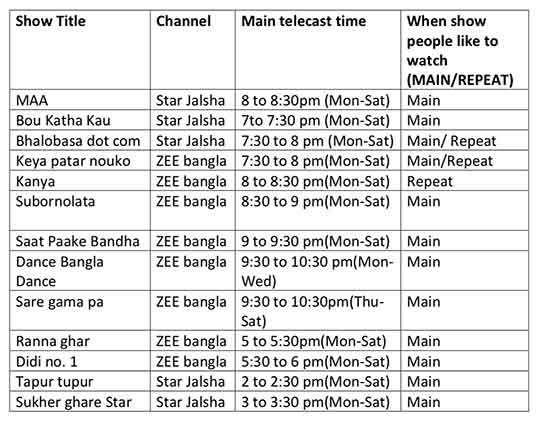
Preference of channels by audiences regarding shows:
 The young generation of multiplex cinema-going audience of Kolkata also follow Hindi GEC channels such as Star One and Colors.
The young generation of multiplex cinema-going audience of Kolkata also follow Hindi GEC channels such as Star One and Colors.
Recommendations
- This research project indicates that most of the respondents’ preference goes for Romantic movie & Comedy movie. Both genre are highly preferred by each & every segment and as well as overall market. Remembering this fact, to release Comedy or Romantic film in Kolkata market may be a wise decision.
- Media plays a big role to promote a movie. Selection of proper media is highly recommended to promote a movie before its release at Kolkata.
- Kolkata cinema market has a potential customer-base of English movie. To develop the market regular PR activity, organising of events before film release, press meet, interview of actors of movie is highly required. This will help to make a loyal English movie audience. It is highly recommended to target young audience of Kolkata & positioning of English movie among them. This may be a wise decision for future aspect, because basic taste & preference regarding movie develops during their school or college life.
- Kolkata film market has a huge opportunity/ possibility for English movie. As there is no other corporate houses (i.e. Warner Brothers, Paramount, Disney) promoting English movie in Kolkata market, so there is big opportunity for SPE to capture the market. If this becomes possible, then SPE can enjoy first movers’ advantage.
[divider size=”1″ margin=”0″]
Cover pic credit: Anirban Mukherjee. At the extreme left is the author, seated along with the audience at the screening of his film Andar Kahini.
See also
https://filmcriticscircle.com/journal/the-appreciation-and-promotion-of-cultural-otherness/
https://filmcriticscircle.com/journal/french-spectators-of-indian-films-bias-and-curiosity/





Leave a Reply
You must be logged in to post a comment.